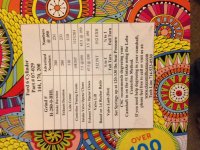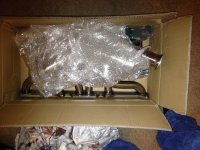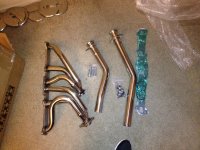69stang_250":14ow4e0g said:
Gene- Your engine is the reason I even thought about going with the 280 cam. I figured if yours could send that maverick into the 14s I could get my mustang into the 13s with the AL head, slightly bigger cam, 4bbl carb, and good clutch.
Its all about relative engine size in the engine family, and
the 3 way formula dynamics Flow= Velocity times port area (Q=v.a,).
and mixture motion (SAE paddle wheel rpm at maximum torque).
engine size can vary from 75% to even 85% from the smallest to the largerst engine size in an engine family, so a 144 with a 280 cam will have radical chop, but a 250 with the same cam might have very little.
If you ever get the chance to drive a Shelby 306 hp or 271 hp 310 degree K code 289, then a 310 degree 351C 4V, the little 289 HP has a heap more lope. Or if you take even a 290 degree Boss 302 Aand compare it to the 290 degree 351 Boss, you'll get the idea. The bigger engine can swallow up the same duration without the whump whump whump creating a stalling issue. My mate Blair told me the best thing when he compared his 295 duration 505 Wade 325 cammed 351 4bbl to a 302 4-bbl Cleveland with the same heads, same carb, same headers. Roy, the engine builder, showed him how the short stroke 302 couldn't even hardly idle with the same cam. Holden used the nWade 325 as a road cam in the 5.0 Special performance 5 liter Commodores, and it idled fine. The difference was having 215 cfm of air flow and big intake poerts vereses the smaller ports. So it can be a delicate balancing act.
A non independent runner engine, like the 4-bbl six, runs pretty much like a
A 144-170 C1 to C5 head has 1.125" ports,
a 1978-1983 big log 200 or 250 has 1.65" average diameter.
1971-1975 2V is 1.65,
2005-2014 CI= 1.6" or so.
X flow Aussie was 1.575" for three years 76-79,
then way down to 1.3775" from 1979-1980,
then down even more to 1.33" from 1981 to 1992.
Ford Australia was prevented from ever doing anything 2V'ish again for 17 long years from 1975 to 1992. And then again for 11 years from 1992 to 2003 regarding turbos. They changed the cam actualtion in 1998 to an optional VCT system, and kept peak duration below 270 degrees.
The last OHV X-flow engine was worked on by SVOAustralia's Dick Johnson, and that engine could take a 280 degree cam in 250 X-flow with 1.73" rocker ratio and 480 thou loft and 215 50 thou duration...and give 196 hp SAE net at the flywheel doing it. Went up from 131 hp with just
a 280 cam,
500 cfm vac sec 2305 carb, and
a set of Perry headers and a little bit of port work.
Head Cfm was 145 at 450 thou lift in 1980 when released, then they went to a bigger valve head with extra mixture motion, but no extra cfm flow. With cam lift that was used, it went up to 165 cfm at 480 thou, and the head now had good mixture motion, but very, very small ports.
The best way I've explained it over the last almost 14 years on the forum is that engine size certainly changes the cam lope factor, and sensitivity to low stall converters. . Mike W 's head has the best mixture motion around, it puts plenty of spin on the mixture, and can cope better with low air speeds without the fuel droplets falling out of suspension. Its very much like the LS1 heads in the 1996 Chevy small block to date, some very special energy was spent of getting some movment into the mixture. So its B-I-G ports, which should hurt idle and when the engine comes "on" a bigger cam, isn't the issue it should be.
The square area in inches at the gasket face is actually pretty small compared to the 1969-1981 Aussie 245/265 Hemi engines and all years of 232/258/4 liter AMC Jeep L6 engines, so your all good for going up on "at lash" cam duration.






